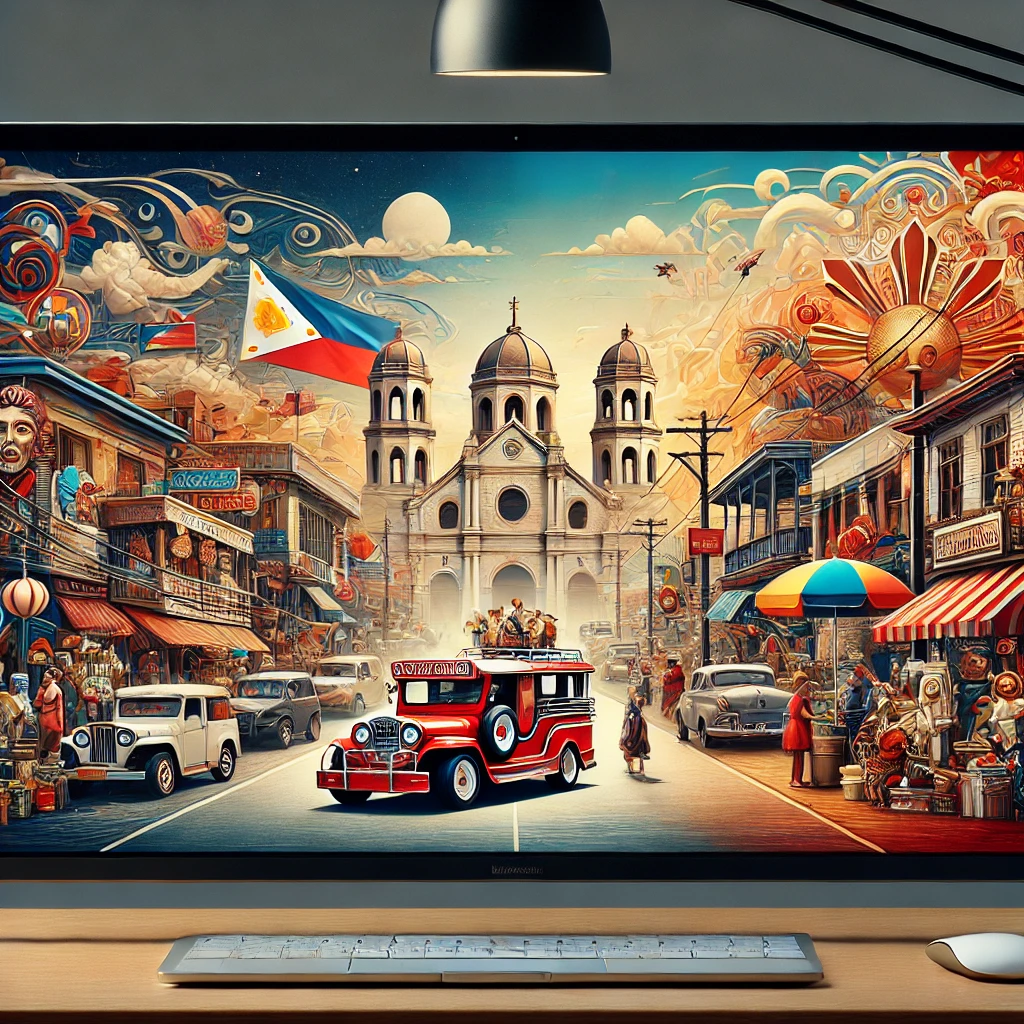Hey there, language lovers and slang enthusiasts! Ready to take a wild ride through the colorful world of Filipino slang? Buckle up, because we’re about to dive deep into the roots, influences, and evolution of the lingo that makes Filipino conversations so darn interesting. From the streets of Manila to the beaches of Boracay, slang has been shaping the way Filipinos communicate for generations. So, let’s get this show on the road and explore the fascinating history of Filipino slang!
The Melting Pot of Languages
A Linguistic Fiesta
Picture this: you’re at a party where Spanish, English, Chinese, Malay, and a bunch of other languages are all mingling, sharing stories, and maybe having a few drinks. That’s pretty much what happened to create the Filipino language we know today. The Philippines has been a melting pot of cultures for centuries, and boy, does it show in the slang!
Filipino, also known as Tagalog, is the national language of the Philippines. But here’s the kicker – it’s not just one language. It’s like a linguistic smoothie, blending influences from various cultures that have left their mark on the archipelago. Spanish colonizers, American occupiers, Chinese traders, and neighboring Southeast Asian countries have all contributed to this linguistic feast.
Let’s break it down with some numbers, shall we?
| Language Influence | Percentage of Loanwords in Filipino |
|---|---|
| Spanish | 33% |
| English | 20% |
| Malay | 10% |
| Chinese | 7% |
| Others | 30% |
These percentages might make your head spin, but they’re a testament to the rich tapestry of influences that have shaped Filipino slang. It’s like a language party where everyone’s invited, and the more, the merrier!
The Spanish Fiesta: Centuries of Influence
¡Hola, Filipino Slang!
Alright, let’s talk about the Spanish influence on Filipino slang. It’s like that one friend who came to visit for a weekend and ended up staying for 333 years. Yep, you heard that right – the Spanish ruled the Philippines from 1565 to 1898, and boy, did they leave their mark on the language!
Spanish words have become so ingrained in Filipino that sometimes, Filipinos don’t even realize they’re using Spanish-origin words. It’s like linguistic inception – slang within slang! Some common Spanish-derived slang terms include:
- “Barkada” (from “barcada” meaning boatload) – now means a group of friends
- “Kubeta” (from “cubo” meaning bucket) – refers to a toilet
- “Pwera” (from “fuera” meaning outside) – used in expressions like “pwera usog” (knock on wood)
But it’s not just individual words. The Spanish influence runs deeper, affecting sentence structures and expressions. For example, the Filipino expression “nosebleed” to indicate difficulty understanding English is believed to have roots in the Spanish phrase “sangre por la nariz” (blood from the nose), used to describe mental strain.
The American Dream: English Slang Takes Over
Welcome to the Cool Club
Fast forward to the 20th century, and enter the Americans, stage left. After the Spanish-American War in 1898, the US took control of the Philippines, bringing with them not just their political ideals but also their language. And let me tell you, English slang hit Filipino youth like a ton of bricks – in a good way!
English words and phrases started to seep into everyday Filipino conversation faster than you can say “cool beans.” This influence accelerated after World War II, with American pop culture becoming increasingly popular in the Philippines. Movies, music, and later, the internet, became vehicles for introducing new slang terms.
Some popular English-derived slang terms include:
- “Lolobin” – a playful way of saying “love” (I lolobin you!)
- “Chuva” – derived from “whatever”
- “Jologs” – meaning tacky or baduy, possibly derived from “yo dawg”
The integration of English into Filipino slang isn’t just about borrowing words. It’s about creating a whole new language hybrid. Enter: Taglish – the beautiful love child of Tagalog and English. It’s like linguistic gymnastics, with speakers effortlessly flipping between the two languages mid-sentence.
The Digital Revolution: Slang Goes Online
Hashtag Blessed
Now, hold onto your smartphones, folks, because we’re entering the digital age! The rise of the internet and social media has turbo-charged the evolution of Filipino slang. It’s like slang on steroids, with new terms popping up faster than you can double-tap an Instagram post.
The online world has given birth to a whole new category of Filipino slang. Text messaging, in particular, has been a goldmine for creative abbreviations and acronyms. Remember, this was back when you had to press a button three times just to get the letter ‘C’. Talk about dedication to communication!
Some popular text slang includes:
- “Jejemon” – a term for excessive use of text speak
- “G” – short for “go” or “game”
- “Petmalu” – reversing the syllables of “malupet” (awesome)
Social media platforms have also played a huge role in popularizing and spreading new slang terms. Facebook, Twitter, and more recently, TikTok, have become breeding grounds for viral slang. It’s like a linguistic petri dish, but way more fun!
Regional Flavors: Slang Across the Archipelago
It’s a Small World After All
Now, let’s hop on our imaginary bangka (boat) and take a tour of the Philippines’ 7,641 islands. Each region has its own distinct flavor of slang, influenced by local languages and cultures. It’s like a linguistic buffet, and trust me, you’ll want to try everything!
In the Visayas, you might hear “Ay sus!” as an exclamation, while in Mindanao, “Pisting yawa!” is a popular expression of frustration. Meanwhile, in Manila, “Ano ba yan?” is the go-to phrase for annoyance. It’s like each region is competing for the title of “Most Creative Slang,” and honestly, they’re all winning.
Here’s a quick tour of some regional slang:
| Region | Slang Term | Meaning |
|---|---|---|
| Cebuano | Amaw | Silly or foolish |
| Ilonggo | Kapoy | Tired |
| Bicolano | Maray | Good |
| Ilocano | Ading | Younger sibling/friend |
This regional diversity in slang is a beautiful reflection of the Philippines’ cultural richness. It’s like each island is adding its own special ingredient to the Filipino language gumbo.
The Evolution Continues: Modern Filipino Slang
Keeping Up with the Cool Kids
Alright, time to put on your coolest shades because we’re diving into the world of modern Filipino slang. It’s a fast-paced, ever-changing landscape where new terms can go viral overnight, and yesterday’s cool phrase might be today’s corny expression.
Modern Filipino slang is like a chameleon, constantly adapting to new trends, technologies, and social phenomena. It’s influenced by everything from K-pop to local celebrities, from political events to viral memes. Keeping up with the latest slang is like trying to hit a moving target – challenging, but oh so fun!
Some popular modern slang terms include:
- “Sana all” – expressing envy or wishful thinking
- “Werpa” – a reversal of “power,” used as encouragement
- “Shookt” – a dramatic way of saying shocked or surprised
But here’s the kicker – by the time you read this, these terms might already be considered “so last year.” That’s the beauty and challenge of slang – it’s always evolving, always fresh, and always a reflection of the current zeitgeist.
The Dark Side of Slang: Controversies and Criticisms
Not All That Glitters Is Gold
Now, let’s get real for a moment. As fun and expressive as slang can be, it’s not without its controversies. Some linguists and educators have raised concerns about the impact of excessive slang use on formal language skills. It’s like worrying that eating too much candy will rot your teeth – except in this case, it’s your grammar that might suffer.
There have been debates about whether the prevalence of slang, particularly in digital communication, is leading to a degradation of language skills among Filipino youth. Some argue that the shortcuts and abbreviations common in text speak are finding their way into formal writing, leading to a decline in language proficiency.
On the flip side, proponents of slang argue that it’s a natural evolution of language, reflecting the creativity and adaptability of its speakers. They see slang as a form of linguistic innovation, not degradation. It’s like the age-old debate of tradition versus progress, played out in the linguistic arena.
Another controversy surrounds the use of “gay lingo” or “swardspeak” in mainstream slang. While it has contributed many popular terms to Filipino slang, there are ongoing discussions about cultural appropriation and the potential for reinforcing stereotypes.
The Future of Filipino Slang: What’s Next?
Crystal Ball, Anyone?
As we wrap up our journey through the history of Filipino slang, let’s put on our futurist hats and take a peek at what might be coming down the linguistic pipeline. Predicting the future of slang is about as easy as nailing jelly to a wall, but hey, let’s give it a shot!
One thing’s for sure – technology will continue to play a huge role in shaping Filipino slang. With the rise of artificial intelligence and virtual reality, who knows what kind of new terms we might see? Maybe we’ll be greeting each other with “Kamusta, hologram!” in a few years.
Global influences will likely continue to shape Filipino slang. K-pop has already made its mark, and as the world becomes increasingly interconnected, we can expect to see more international flavors in Filipino slang. It’s like linguistic globalization, but way more fun than that sounds.
Climate change and environmental issues might also influence future slang. We might see more terms related to sustainability, eco-friendliness, or extreme weather events. “That’s so carbon neutral of you!” could be a compliment of the future.
But perhaps the most exciting aspect of future Filipino slang is its unpredictability. Slang, by its very nature, is spontaneous, creative, and often defies expectations. It’s like linguistic jazz – you never know where it’s going to go, but you know it’s going to be an interesting ride.
The Never-Ending Story of Filipino Slang
As we reach the end of our linguistic adventure, one thing is clear – the story of Filipino slang is far from over. It’s a living, breathing entity that continues to evolve with each passing day, each new technology, and each cultural shift.
From its roots in the melting pot of languages that is the Philippines, through centuries of foreign influences, to the digital revolution and beyond, Filipino slang has proven to be resilient, adaptable, and endlessly creative. It’s a testament to the Filipino spirit – always ready to embrace the new while holding onto the essence of what makes it unique.
So the next time you hear a new slang term that makes you go “Ano daw?” (What did they say?), remember – you’re witnessing language evolution in real-time. It’s like being present at the birth of a new species, except instead of waiting millions of years, it happens in the blink of an eye.
Keep your ears open, your mind curious, and who knows? Maybe you’ll be the one to coin the next viral Filipino slang term. Until then, stay cool, stay curious, and keep slinging that slang!
Disclaimer: This blog post is based on research and general knowledge about Filipino slang up to 2022. Language evolves rapidly, and some terms or information may have changed since then. If you notice any inaccuracies, please report them so we can correct them promptly. Remember, when it comes to slang, change is the only constant!




